Last Updated on February 29, 2024
According to EWG, “fragrance” or “parfum” on a product label represents an undisclosed mixture of various scent chemicals and ingredients used as fragrance dispersants such as diethyl phthalate.
EWG further acknowledges fragrance mixes have been associated with allergies, dermatitis, respiratory distress and potential effects on the reproductive system. They give “fragrance” a score of 8, 1 being the best and 10 being the worst for human (and environmental) health.

I personally try to avoid items that heavily rely on fragrance. They give me really intense headaches.
This includes items like air fresheners, fabric softeners, scent boosters, and perfume. Many of these products contribute to indoor air pollution, which is typically 5x more polluted than outdoor levels, according to the EPA, which can negatively impact our health.
In fact, half of the volatile organic compounds (VOCs), the building blocks of smog, studied from roadside air in Los Angeles came from household products! The other half came from vehicles.
I try to improve the air quality of my home by making my own DIY Febreze, making a simmer pot, or simply opening a window. I also avoid using conventional perfumes, as these trigger my headaches.
When it comes to perfume, I like to support sustainable perfume brands, or make my own DIY natural perfume. Here’s everything you need to know regarding natural perfume, and how I make my own.

what is a natural perfume?
A natural perfume is a fragrance derived from natural aromatics that are extracted from nature, such as trees, flowers and plants. Natural perfumes contain little to no synthetic ingredients.
A natural perfume will often contain essential oils and carrier oil. The essential oils’ fragrance characteristics are classified as notes. There are top notes, middle notes, and base notes.
Here’s a bit about each fragrance note:
- Top notes are light, fresh and fast acting. It’s usually the first scent you smell in a blend. They tend to evaporate quickly. Examples include grapefruit, orange, peppermint and lemongrass.
- Middle notes help balance the blend. You probably won’t smell them right away, but the soft scent may become apparent after a minute or two. Examples include rose, lavender and cinnamon bark.
- Base notes are strong and heavy, which ground the blend in their long-lasting scent. Examples include sandalwood, frankincense, cedarwood and patchouli.
Synthetic fragrances can replicate the scent of natural fragrances but are developed in laboratories.
Synthetic fragrances can have adverse health effects, as many are derived from petroleum by-products. Chemicals found in fragrances include phthalates, which are endocrine disruptors, and carcinogens benzophenone and styrene. In addition, some children and adults have allergic reactions to fragrance chemicals.
sustainable sourcing of natural fragrances
One benefit of synthetic fragrance over natural is that they do not require the harvesting of scents from trees or plants. Therefore, there’s no risk of overharvesting or damaging an ecosystem.
Frankincense collection can damage trees and threaten the livelihoods of villages who depend on them. High demand means that many trees are being over-exploited, and populations are at risk of dying out.
However, this is why it’s equally important we know where the ingredients in our perfume come from, and how it is sourced.
The most sustainable thing you can do is use the essential oils you already own to make your own DIY perfume (more on how to do this later).
If you’d like to make your own natural perfume and need to buy new essential oils, I recommend looking into brands that use organic ingredients and sustainable harvesting methods.
Not every essential oil brand is created equal, so choose brands that are harvesting their plants ethically like doTerra, Jade Bloom, Mountain Rose Herbs, and Plant Therapy.
It is also worth noting that even natural fragrances can have adverse health effects and trigger allergic reactions. So be mindful of this as you experiment with natural perfumes too.
is there an organic perfume?
Yes there are organic perfumes for sale on the market. If you’re looking for pre-made perfumes that contain natural, clean ingredients, here are the best non-toxic perfume brands.

how can I smell good naturally without perfume?
You can smell good naturally without perfume in many ways. Here are a few simple ways to smell good naturally without perfume:
- Spritz yourself and your clothes with some rose water
- Apply natural deodorant daily
- Add a lavender bud or rose petal sachet to your clothing drawer
- Shower right after a workout and on a frequent basis using scented bar soap, like the ones from Lush
- Use one of these organic shampoos to clean your hair and make it smell great
- Keep up with dental hygiene: Brush your teeth twice a day, floss, and go to dental checkups every 6 months
- Eat more plant based: According to a study, eating a nonmeat diet was found to improve odor and vegetarian participants were judged as significantly more pleasant odor-wise
what can I use as a natural perfume?
There are many natural perfume options you can DIY yourself. Many times, herbs and spices can be used to make natural perfume, as well as essential oils.
I personally prefer to make an infusion using rose petals, lavender petals, and chamomile flowers bought in bulk from my local tea shop. You can infuse other types of herbs to get a different scent.
The other recipes below are natural perfume using essential oil blends. Before I go into the recipes, I’d like to share with you a few examples of essential oil blends and carrier oils, as they will be mentioned in the following recipes.

essential oil blends
These are some examples of essential oil combinations that work well together. Use it as inspiration, but feel free to play around and make up your own scents as well.
You can also play around with the number of drops you give each essential oil, but I recommend sticking to 10 drops max overall if you’re putting your DIY perfume in a 10ml glass bottle.
springtime blend
- Top note: 3 drops of tangerine essential oil
- Middle note: 5 drops of lemongrass essential oil
- Base note: 2 drops of peppermint essential oil
mysterious and sultry blend
- Top note: 3 drops of bergamot essential oil
- Middle note: 5 drops of jasmine essential oil
- Base note: 2 drops of vanilla essential oil
dreamy and romantic blend
- Top note: 3 drops of rose essential oil
- Middle note: 5 drops of ylang-ylang essential oil
- Base note: 2 drops of patchouli essential oil
earthy blend
- Top note: 3 drops of citrus (lime, lemon or sweet orange) essential oil
- Middle note: 5 drops pine, cinnamon, or nutmeg essential oil
- Base note: 2 drops of sandalwood or cedarwood essential oil
carrier oils
Carrier oils are oils used to suspend and deliver essential oils. They’re the base you add essential oils to so they are diluted before you apply them to your skin, which can prevent irritation. Ideally, you want your carrier oil to be thin and without a strong fragrance, so the essential oils can be the star.
Examples of carrier oils include:
- Fractionated coconut oil
- Sweet almond oil
- Grapeseed oil
- Jojoba oil
- Saffron oil

1. floral infused oil perfume
This DIY natural perfume recipe is from my book, 101 Ways to Go Zero Waste. Be sure to check it out for more recipes like this.
For this recipe, you’ll need a small 8-ounce swing-top jar to store the mixture in while it’s being prepared, and a little roll-on bottle to strain it into once it’s ready.
Ingredients:
- 1/4 cup dried rose petals
- 1/4 cup lavender petals
- 1/4 cup dried chamomile flowers
- 1 cup safflower oil
- 2 tablespoons vitamin E oil
Instructions:
- Add the dried flowers to an 8-ounce swing-top jar. Pour the safflower oil over the flowers and close the jar. Place the jar on the windowsill and shake once a day for 2 to 3 weeks. The oil will be infused with a beautiful floral scent.
- Strain the flowers out and pour the scented oil into a roll-on bottle.
- Apply the scented oil to your hot spots like wrists, behind the elbows, behind the knees, behind your ears, and where the collarbone meets in the middle.

2. essential oil roll-on perfume
This perfume is perfect for those who prefer applying perfume directly onto their skin. It’s subtle, but wonderful for applying on dates or around friends. They’ll get a nice whiff when you give them a hug! Apply to your hot spots (behind the ears, wrists, etc.) for the best results.
Ingredients:
- 10 drops of essential oil blend of your choice
- 9 ml carrier oil of your choice to top off a 10 ml roll-on bottle
- Fresh and/or dried herbs and flowers (optional)
Instructions:
- Fill your perfume bottle with a carrier oil. If you don’t want your perfume bottle to have any color, choose fractionated coconut oil. The other oils will be in various shades of amber and green.
- Add the 10 drops of your chosen essential oil blend to your 10ml bottle.
- Add in your combination of fresh and dried flowers, leaves, or petals to decorate the bottle. This can be rose petals, lavender petals, calendula petals, etc.

3. essential oil perfume spray
Ideal for those who prefer to spray on their perfume. Or, for those who like to spray their clothes to infuse them with a nice scent! Just a few spritz and you’ll be ready to walk out the door.
ingredients:
- ½ tsp of jojoba oil
- 10 drops of essential oil blend of your choice
- vodka or witch hazel to top off a 10 ml spray bottle
instructions:
- Using a small funnel, combine the jojoba oil and essential oils in the spray bottle. Replace the lid and shake well.
- Fill the bottle the rest of the way with witch hazel. Replace the lid and shake it up well to combine.
Would you try any of these DIY natural perfume recipes? Let me know in the comments!
The post What is Natural Perfume? + 3 Simple DIY Perfumes appeared first on Going Zero Waste.
Green Living
6 Best Non Toxic Diapers For Babies
Last Updated on October 15, 2025
Did you know the average newborn goes through 10-12 diapers per day? That’s a lot of waste – and a lot of time spent in diapers.
Most babies have more sensitive skin than adults, as their skin hasn’t fully developed yet. The protective hydrolipidic film is still very thin, which makes infant skin more vulnerable to harsh external factors.

Some of the links in this post are affiliate links; for more information please see my disclosure policy.
Those external factors include diapers. Babies spend a lot of time getting in (and out) of them. So it’s important to choose non toxic diapers that are gentle on both skin and planet. Here are the best non toxic diapers on the market.
which diapers are the least toxic?
The diapers that are least toxic include ones made from plant-based or cotton materials. Look for brands that omit harsh chemicals like chlorine, phthalates, and PFAs.
Many diaper components are made up of plastic, which is hard to avoid in the name of efficiency.
That being said, it’s best to choose diapers from brands that minimize the amount of plastic in their products. Plastic materials can emit VOCs known to harm health.
Here are some general guidelines to adhere to when choosing diapers:
- Choose diapers that disclose the ingredients (some don’t!). Avoid anything with fragrance, lotion, or other skin-conditioning adhesives.
- Look for brands that minimize the amount of plastic in their products.
- Consider cloth diapers, ideally made from organic cotton.
- Opt for brands that use unbleached pulp or pulp bleached without chlorine
- Try to choose plain, undyed diapers with minimal designs (dyes can be contaminated with toxic heavy metals).
- Check for certifications like Forest Stewardship Council or EWG certified.
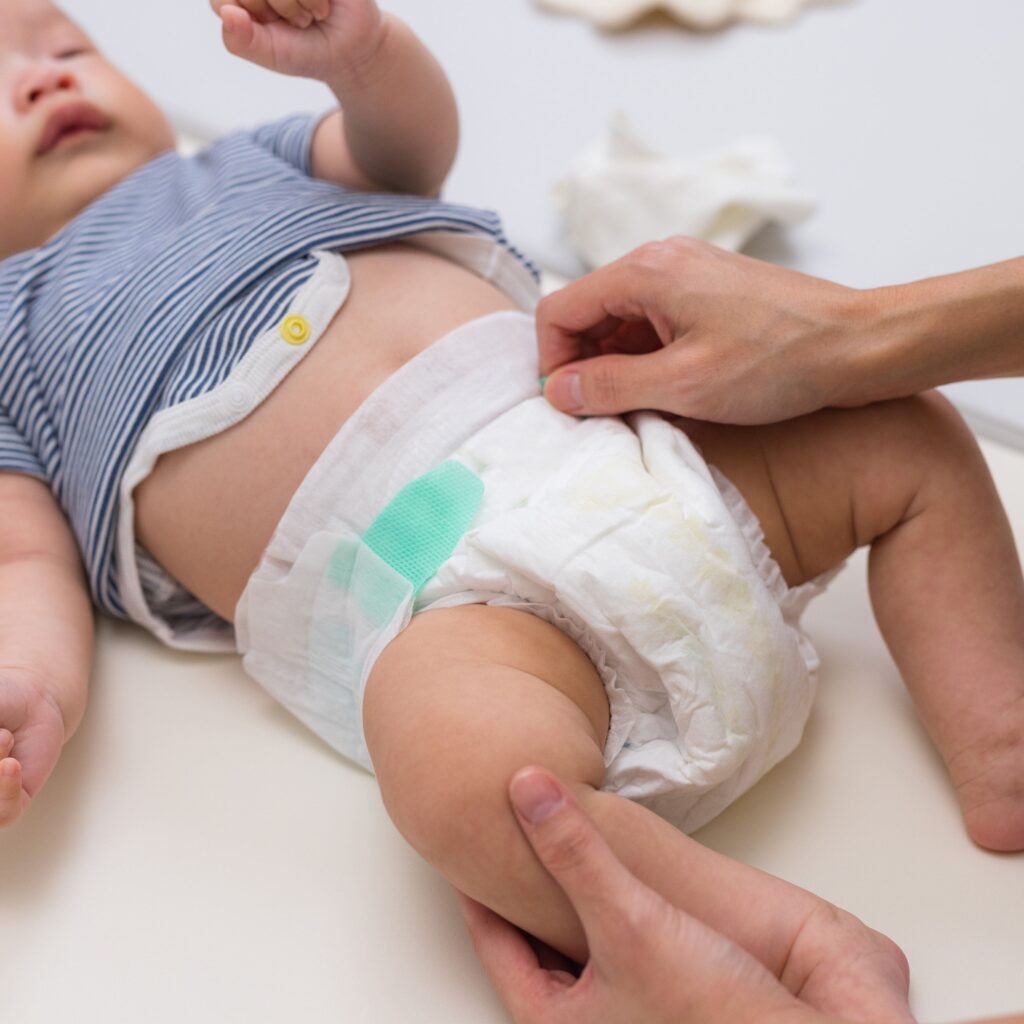
is Huggies or Pampers less toxic?
In terms of being less toxic, Huggies has stated all of their diapers are free of fragrances, phthalates, parabens, and elemental chlorine. They’ve also partnered with Terracycle to offer plastic film recycling options.
Pampers diapers are made without parabens, natural rubber latex and elemental chlorine. But only their Pure diapers are made without fragrance (and many mothers online have complained of Pampers’ strong scent).
However, Pampers’ factories are zero manufacturing waste to landfill and they use FSC certified wood pulp.
Both brands list their ingredients on their websites, so definitely read them for yourself before making a purchase. Just be mindful both brands also use colorants and printing inks to make designs and/or color change technology.
which diaper brands are safe for babies?
The diaper brands safe for babies are listed below. There’s a mix of disposable and cloth diapers, so there’s something for everyone.
However, be mindful that every baby is different and what works for one, doesn’t always work for another. For example, certain brands may fit your baby like a glove, whereas others may be too big: It’s all about experimenting and finding what works for your baby.
You can use this list as a starting point to help you choose a better, safer choice for your child. None of the brands listed here use fragrance, parabens, or other harsh chemicals.
I’ve gone ahead and highlighted some of my favorite features of each brand, but it isn’t an exhaustive list. Be sure to check out their websites for more information.
Also, if you cloth diaper, don’t forget to consider eco-friendly baby detergent brands because you’ll be doing a bit more laundry!
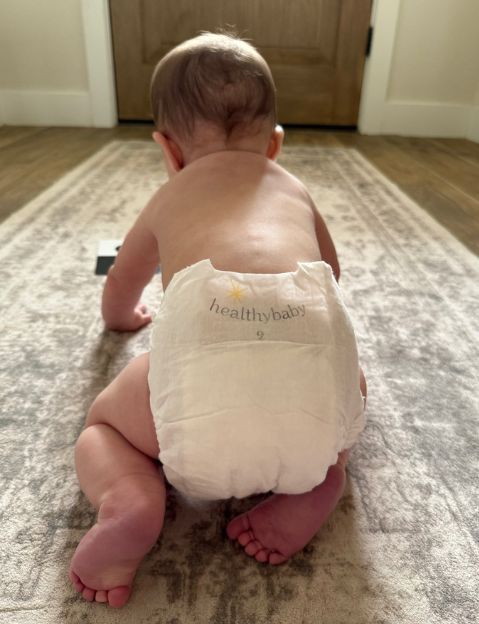
1. healthy baby
- Offers disposable and cloth diapering options
- Six sizes, not including newborn (N or N/1)
- Plant-based materials including organic cotton + FSC certified pulp
- 12 hour leak protection
- No chemical wetness indicator
- EWG certified
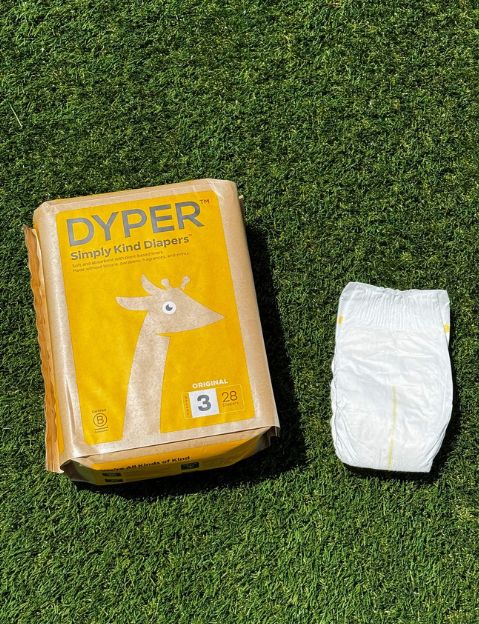
2. dyper
- Disposable diapers
- Six sizes, not including newborn (NB)
- Plant-based materials, including FSC-certified pulp
- 12-hour leak protection
- No inks, prints or dyes
- Offers REDYPER service to compost diapers through weekly pickup
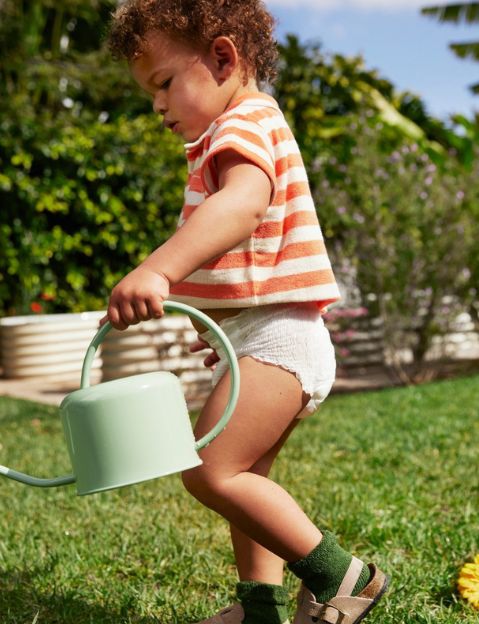
3. coterie
- Disposable diapers
- Seven sizes, not including newborn (N or N+1)
- 25% plant-based, made with wood pulp from sustainably manages forests
- 12-hour leak protection
- Wetness indicator
- Cruelty-free
- OEKO-TEX STANDARD 100 Certified
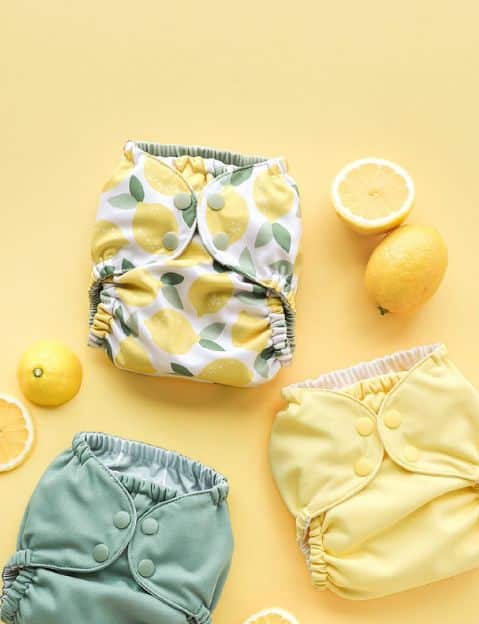
4. esembly baby
- Cloth diapers
- Two sizes, based on pounds
- Made of organic cotton + upcycled TPU
- Recommended to change an awake baby every 2-3 hours
- Wet bags sold separately to hold dirty diapers while out
- Pre-loved options to buy and sell available
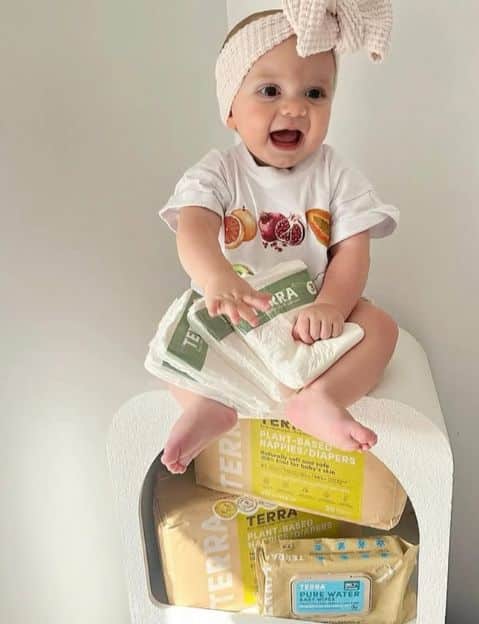
5. terra
- Disposable diapers
- Six sizes
- 85% plant-based, including FSC-certified pulp
- 12-hour leak-proof protection
- Plant-based wetness indicator
- Ink on product + packaging is food grade
- Packaging is made from recyclable kraft paper + rice
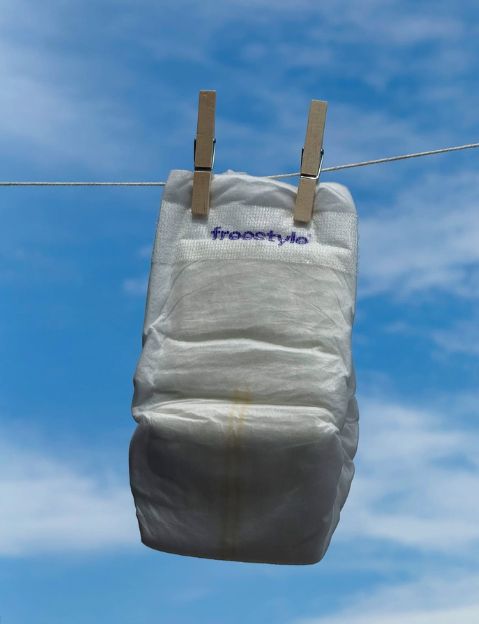
6. freestyle
- Disposable diapers
- Six sizes
- 7-layer protection for 14x better absorption
- Delivered in 1 month long supplies
- FSC certified pulp
- EWG verified
Which of these sustainable diaper options would you choose? Let me know in the comments!
The post 6 Best Non Toxic Diapers For Babies appeared first on Going Zero Waste.
Green Living
The Many Layers of Personal Style
Personal style is a dance between dualities: fashion as art and fashion as function; clothing as self-expression and clothing for our circumstances.
Style is a medium for communication and self-expression, yes. But it’s also shaped by the environments and requirements around us, from workplace dress codes to city cultures, climates, and specific occassions.
In last Saturday’s workshop, where we talked about how to remix what you already have in your closet, attendees shared a common challenge:
How do you balance your personal style expression while dressing for the various situations and environments we operate in?
“I’ve found above all else my style is highly influenced by my environment (my job, my city etc.)—sometimes it becomes about ‘fitting in’ and losing individuality”
“I find I’m too led by my day-to-day lifestyle. I WFH and so often I just don’t get dressed at all.”
“There are too many applications: workout, work, at home, formal occasion.”
Style as Identity vs. Style as Communication
It’s no wonder style and getting dressed can feel so confusing.
In the personal style world, we learn to dress for who we are on the inside. And then we see the style rules in fashion media: here’s how to dress for this season, this dress code, this city.
And in our real lives, we have real dress codes we might have to follow, whether for a workplace or a wedding.
But what if all those sides conflict?
- If my style words are “casual” or “sporty” but I’m in a workplace 40+ hours a week that requires business formal, where does that leave my personal style?
- If I love vibrant and artsy looks, but I live in a city full of neutrals, what do I wear?
It’s no surprise it feels… complicated.
Here’s my take.
We’re Not One-Dimensional — Neither is Our Style
Sometimes I want to disconnect and live in cottage in the mountains, surrounded by more trees than people. Other days I dream of having an apartment in the center of Paris where I see more people in a day than live in my hometown.
I’m light, joyful, maybe even quirky with friends. I’m ambitious, intentional, perhaps more serious in work. There are times I feel it’s best to soften and let it go; other times it feels most aligned to be unapologetically outspoken.
We are human. We’re social creatures. We’re complex and full of contradictions.
Social media has trained us to fit people into neat boxes because “niche” is what performs in the algorithm.
In real life, though, our “authentic” selves aren’t so one-dimensional.
I’m not speaking to new networking contacts the same exact way I talk to my best friend I’ve known for years. That doesn’t mean I’m pretending to be someone else. It just means I’m showing up a bit differently depending on the context.
Similarly, our personal style doesn’t have to be expressed in one singular way.
That’s what’s beautiful about fashion! We have the opportunity to express ourselves a bit differently each and every time we get dressed.
What we wear might ebb and flow with a situation, the season, or our mood. There are common threads, but differentiators too.
Three distinctly different looks can all be authentic.
For me, personal style isn’t about being setting such rigid parameters that we can no longer embrace our multi-dimensional nature.
And there’s undoubtedly the layers of privilege at work here too. Is it safe to dress in alignment with your true identity in that particular situation? Will you be taken seriously? Could there be repercussions?
There’s a lot to untangle when it comes to what we wear.
Making Our Multi-Dimensional Style Practical
As I shared in last week’s workshops, style is many layers. The four I see it through are the vibe, the shapes, the colors & textures, and our lifestyle & values.

The aesthetic reflects your vibe, mood or style adjectives.
- For example, my vibe or adjectives are feminine, structured, grounded.
The shapes are the fits, silhouettes, and proportions you love.
- I often wear outfits with a straight silhouette or tailored fit balanced with a relaxed, flowy, or drapey element.
Colors & textures include your preferred palettes, fabrics, and the way materials feel.
- I prefer wearing natural fibers when possible. I like gold jewelry, and I feel more aligned in lower contrast looks. Lighter colors for day. Sometimes darker for evening or certain events.
The lifestyle & values element is the consideration of your actual day-to-day. What situations and environments are you dressing for? What is important to you?
- I work from home so comfort is key most of the time. I value slow fashion practices — rewearing, repairing, and supporting circular practices and sustainably-minded brands.
Once you understand these layers of your style, the next step is figuring out how to apply them in real-life situations.
Applying Your Style to the Situation
In last week’s workshops, I talked about the role of outfit templates here for various situations. What is the foundational blueprint of what you might wear to your office, working from home, in a school setting, at home, running errands, and so on?
There are opportunities to bring in the layers of your personal style in these various situations, but it does require some intentionally on the outset. Otherwise, it’s easy to fall into our old patterns or copy what others around us wear. (Even subconsciously, as fashion psychologist Shakaila Forbes-Bell has shared!)

Here’s one of my work-from-home outfit templates that balances style and situational needs:
- Blouse with feminine detail: I start with the top for Zoom calls!
- Straight-leg bottoms: this could be jeans, colorful pants, or a column skirt
- Slim shoes: the general “slim” descriptor makes it versatile across seasons
- Structured bag: an option to add polish when coworking at a café
By thinking in these various layers (vibe, shapes, colors & textures, and lifestyle & values) you can build outfits that feel authentic to you while fitting the constraints of the external situation.
What About One-Off Unique Situations?
Like this Wednesday evening, I spoke on a “Sustainable Fashion in Action” panel with Chicago Climate Connect during Sustainable Fashion Week Chicago. But the panel was also taking place at the Patagonia x Worn Wear store.
So the vibe was professional meets fashion, but also kinda casual?! And we are still in the Midwest here. I have to say, this one wasn’t easy.
But here’s the step-by-step thought process that helped me balance my style, function, and a unique-to-me context.

- I picked a foundational piece: My navy wide-leg trousers were business casual without being too formal and were practical for train travel.
- And functional accessories:My old Coach bag fits everything and my chunky Veja sneakers matched the vibe I was going for so those were the picks.
- Then a piece that brought it all together:At this point I was mixing high-contrast colors (white with navy & black) and different vibes (trousers vs. sneakers). I felt like I needed a bridge for the outfit, and this navy-striped vest tied it all together.
- Finally, some final touches: Gold jewelry made the look feel more “me”, while this cap from Abbie at The Filtery made it all feel effortless.
In the end, this outfit took a lot longer to create than a typical look.
It took longer to create than my usual outfits, but it felt just right. The combination was practical, suited my style, fit the vibe of the panel, and aligned with the weather.
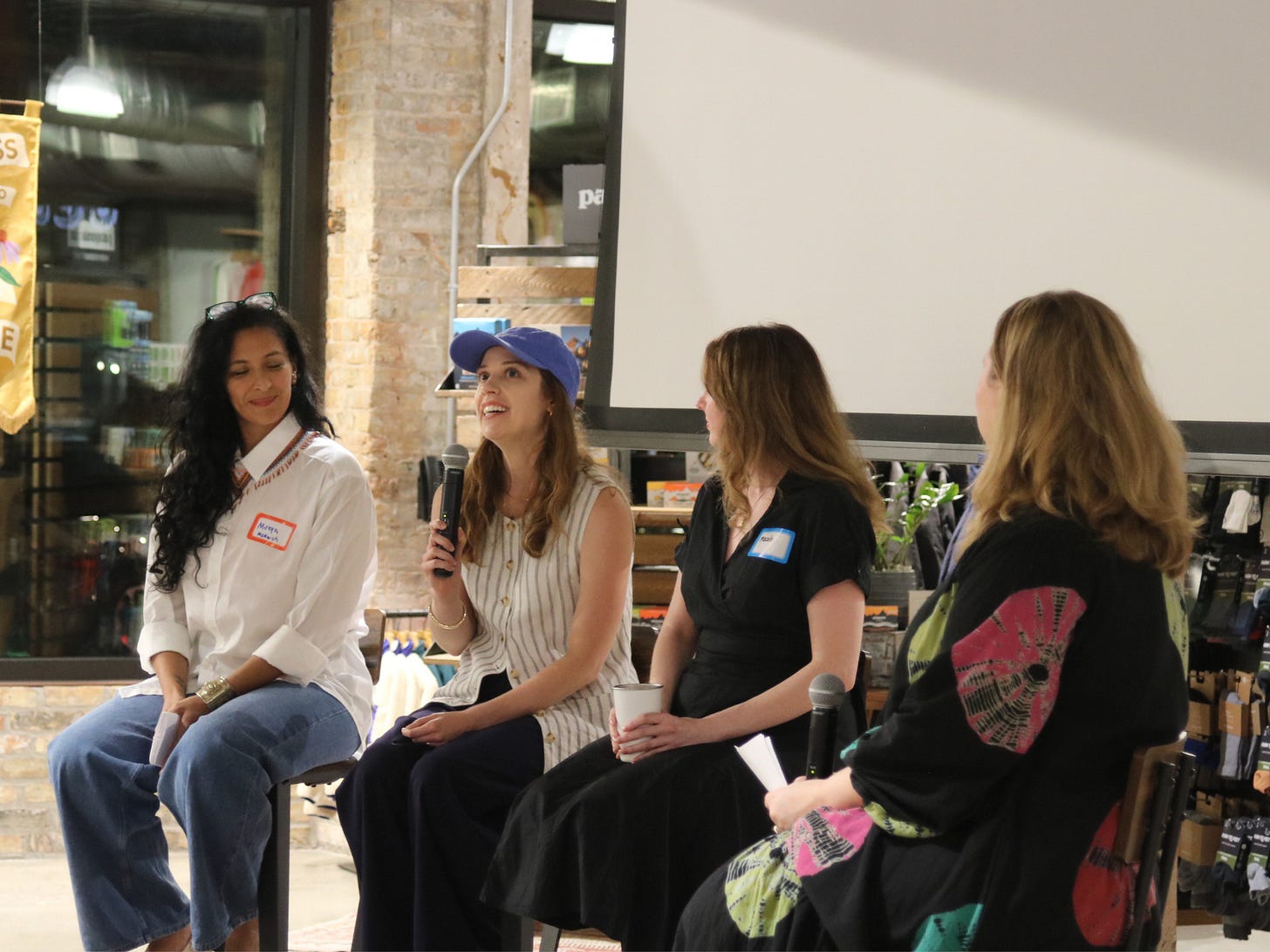
This panel outfit reminded me that style is what we wear to express ourselves, but it’s also a tool to help us navigate our lives. By thinking through these layers of personal style (vibe, shapes, colors, textures, and lifestyle needs) we can balance showing up authentically while honoring the nuances or navigating the constraints of a situation.
For me, that’s the real power of personal style.
One single outfit can’t tell the whole story of who we are. But personal style can be flexible, functional, and expressive of the many sides of our multi-dimensional nature.
So lately, more than asking “does this outfit perfectly express my full self?” I’ve been finding myself asking:
“Does this outfit help me show up in the way I want to? Does it say what I want it to say in this particular moment?“
The post The Many Layers of Personal Style appeared first on .
Green Living
You’re multi-dimensional. So is your style.
Personal style is a dance between dualities: fashion as art and fashion as function; clothing as self-expression and clothing for our circumstances.
Style is a medium for communication and self-expression, yes. But it’s also shaped by the environments and requirements around us, from workplace dress codes to city cultures, climates, and specific occassions.
In last Saturday’s workshop, where we talked about how to remix what you already have in your closet, attendees shared a common challenge:
How do you balance your personal style expression while dressing for the various situations and environments we operate in?
“I’ve found above all else my style is highly influenced by my environment (my job, my city etc.)—sometimes it becomes about ‘fitting in’ and losing individuality”
“I find I’m too led by my day-to-day lifestyle. I WFH and so often I just don’t get dressed at all.”
“There are too many applications: workout, work, at home, formal occasion.”
Style as Identity vs. Style as Communication
It’s no wonder style and getting dressed can feel so confusing.
In the personal style world, we learn to dress for who we are on the inside. And then we see the style rules in fashion media: here’s how to dress for this season, this dress code, this city.
And in our real lives, we have real dress codes we might have to follow, whether for a workplace or a wedding.
But what if all those sides conflict?
- If my style words are “casual” or “sporty” but I’m in a workplace 40+ hours a week that requires business formal, where does that leave my personal style?
- If I love vibrant and artsy looks, but I live in a city full of neutrals, what do I wear?
It’s no surprise it feels… complicated.
Here’s my take.
We’re Not One-Dimensional — Neither is Our Style
Sometimes I want to disconnect and live in cottage in the mountains, surrounded by more trees than people. Other days I dream of having an apartment in the center of Paris where I see more people in a day than live in my hometown.
I’m light, joyful, maybe even quirky with friends. I’m ambitious, intentional, perhaps more serious in work. There are times I feel it’s best to soften and let it go; other times it feels most aligned to be unapologetically outspoken.
We are human. We’re social creatures. We’re complex and full of contradictions.
Social media has trained us to fit people into neat boxes because “niche” is what performs in the algorithm.
In real life, though, our “authentic” selves aren’t so one-dimensional.
I’m not speaking to new networking contacts the same exact way I talk to my best friend I’ve known for years. That doesn’t mean I’m pretending to be someone else. It just means I’m showing up a bit differently depending on the context.
Similarly, our personal style doesn’t have to be expressed in one singular way.
That’s what’s beautiful about fashion! We have the opportunity to express ourselves a bit differently each and every time we get dressed.
What we wear might ebb and flow with a situation, the season, or our mood. There are common threads, but differentiators too.
Three distinctly different looks can all be authentic.
For me, personal style isn’t about being setting such rigid parameters that we can no longer embrace our multi-dimensional nature.
And there’s undoubtedly the layers of privilege at work here too. Is it safe to dress in alignment with your true identity in that particular situation? Will you be taken seriously? Could there be repercussions?
There’s a lot to untangle when it comes to what we wear.
Making Our Multi-Dimensional Style Practical
As I shared in last week’s workshops, style is many layers. The four I see it through are the vibe, the shapes, the colors & textures, and our lifestyle & values.

The aesthetic reflects your vibe, mood or style adjectives.
- For example, my vibe or adjectives are feminine, structured, grounded.
The shapes are the fits, silhouettes, and proportions you love.
- I often wear outfits with a straight silhouette or tailored fit balanced with a relaxed, flowy, or drapey element.
Colors & textures include your preferred palettes, fabrics, and the way materials feel.
- I prefer wearing natural fibers when possible. I like gold jewelry, and I feel more aligned in lower contrast looks. Lighter colors for day. Sometimes darker for evening or certain events.
The lifestyle & values element is the consideration of your actual day-to-day. What situations and environments are you dressing for? What is important to you?
- I work from home so comfort is key most of the time. I value slow fashion practices — rewearing, repairing, and supporting circular practices and sustainably-minded brands.
Once you understand these layers of your style, the next step is figuring out how to apply them in real-life situations.
Applying Your Style to the Situation
In last week’s workshops, I talked about the role of outfit templates here for various situations. What is the foundational blueprint of what you might wear to your office, working from home, in a school setting, at home, running errands, and so on?
There are opportunities to bring in the layers of your personal style in these various situations, but it does require some intentionally on the outset. Otherwise, it’s easy to fall into our old patterns or copy what others around us wear. (Even subconsciously, as fashion psychologist Shakaila Forbes-Bell has shared!)
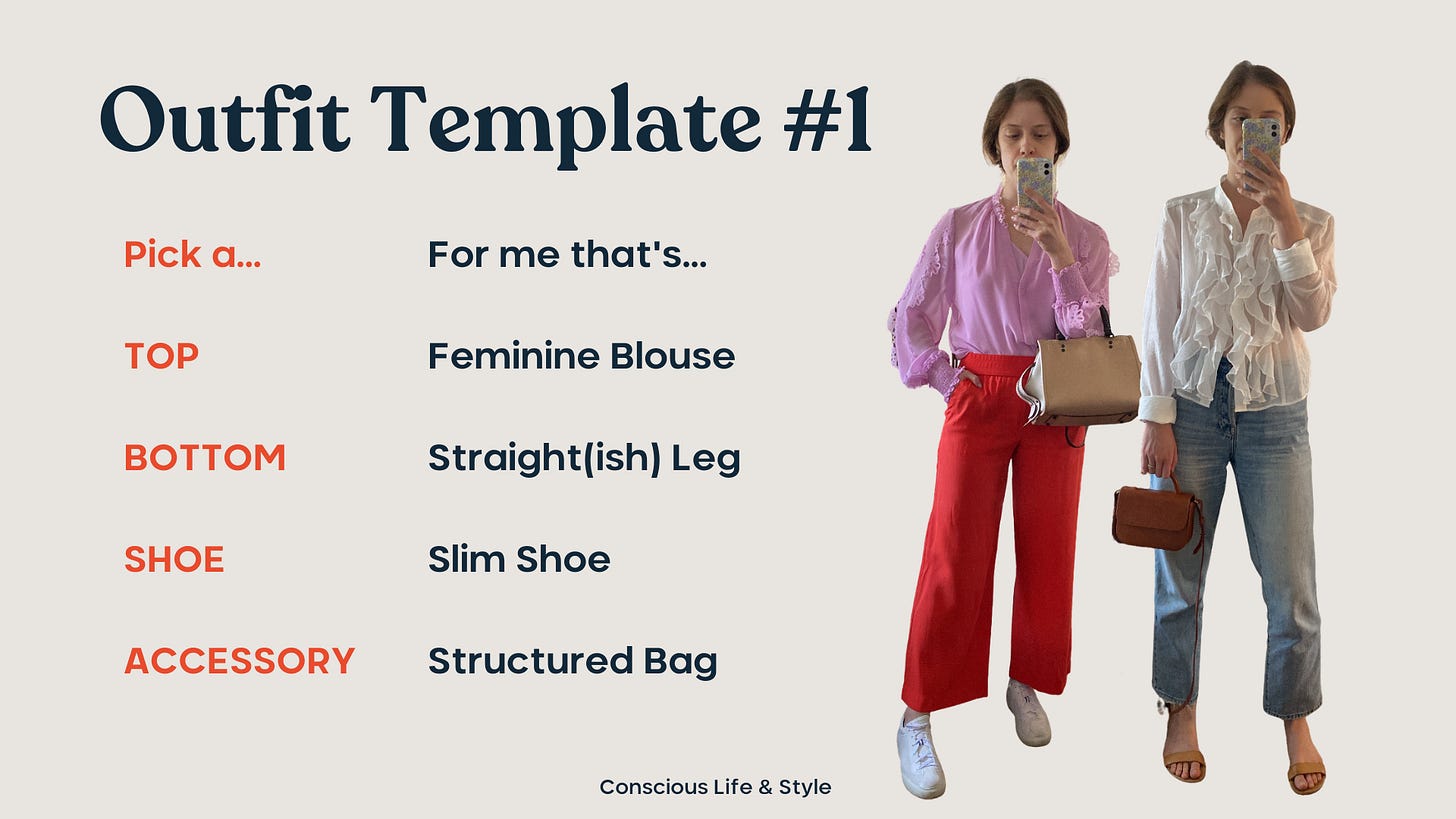
Here’s one of my work-from-home outfit templates that balances style and situational needs:
- Blouse with feminine detail: I start with the top for Zoom calls!
- Straight-leg bottoms: this could be jeans, colorful pants, or a column skirt
- Slim shoes: the general “slim” descriptor makes it versatile across seasons
- Structured bag: an option to add polish when coworking at a café
By thinking in these various layers (vibe, shapes, colors & textures, and lifestyle & values) you can build outfits that feel authentic to you while fitting the constraints of the external situation.
What About One-Off Unique Situations?
Like this Wednesday evening, I spoke on a “Sustainable Fashion in Action” panel with Chicago Climate Connect during Sustainable Fashion Week Chicago. But the panel was also taking place at the Patagonia x Worn Wear store.
So the vibe was professional meets fashion, but also kinda casual?! And we are still in the Midwest here. I have to say, this one wasn’t easy.
But here’s the step-by-step thought process that helped me balance my style, function, and a unique-to-me context.
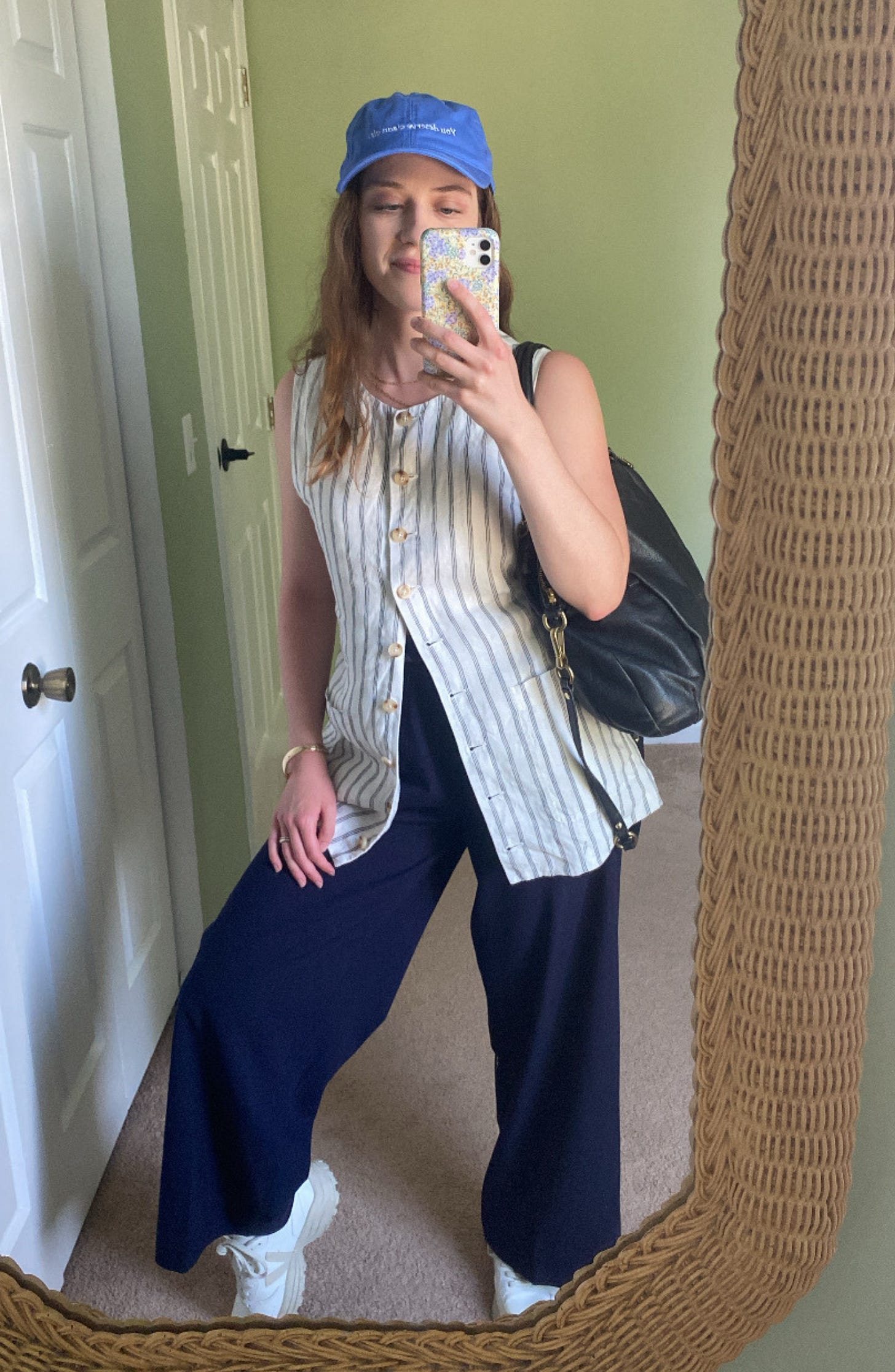
- I picked a foundational piece: My navy wide-leg trousers were business casual without being too formal and were practical for train travel.
- And functional accessories:My old Coach bag fits everything and my chunky Veja sneakers matched the vibe I was going for so those were the picks.
- Then a piece that brought it all together:At this point I was mixing high-contrast colors (white with navy & black) and different vibes (trousers vs. sneakers). I felt like I needed a bridge for the outfit, and this navy-striped vest tied it all together.
- Finally, some final touches: Gold jewelry made the look feel more “me”, while this cap from Abbie at The Filtery made it all feel effortless.
In the end, this outfit took a lot longer to create than a typical look.
It took longer to create than my usual outfits, but it felt just right. The combination was practical, suited my style, fit the vibe of the panel, and aligned with the weather.

This panel outfit reminded me that style is what we wear to express ourselves, but it’s also a tool to help us navigate our lives. By thinking through these layers of personal style (vibe, shapes, colors, textures, and lifestyle needs) we can balance showing up authentically while honoring the nuances or navigating the constraints of a situation.
For me, that’s the real power of personal style.
One single outfit can’t tell the whole story of who we are. But personal style can be flexible, functional, and expressive of the many sides of our multi-dimensional nature.
So lately, more than asking “does this outfit perfectly express my full self?” I’ve been finding myself asking:
“Does this outfit help me show up in the way I want to? Does it say what I want it to say in this particular moment?“
The post You’re multi-dimensional. So is your style. appeared first on .
-
Climate Change2 years ago
Spanish-language misinformation on renewable energy spreads online, report shows
-
Climate Change3 months ago
Guest post: Why China is still building new coal – and when it might stop
-
Climate Change Videos2 years ago
The toxic gas flares fuelling Nigeria’s climate change – BBC News
-

 Greenhouse Gases1 year ago
Greenhouse Gases1 year ago嘉宾来稿:满足中国增长的用电需求 光伏加储能“比新建煤电更实惠”
-
Greenhouse Gases3 months ago
Guest post: Why China is still building new coal – and when it might stop
-

 Climate Change1 year ago
Climate Change1 year ago嘉宾来稿:满足中国增长的用电需求 光伏加储能“比新建煤电更实惠”
-

 Carbon Footprint2 years ago
Carbon Footprint2 years agoUS SEC’s Climate Disclosure Rules Spur Renewed Interest in Carbon Credits
-
Renewable Energy3 months ago
US Grid Strain, Possible Allete Sale



